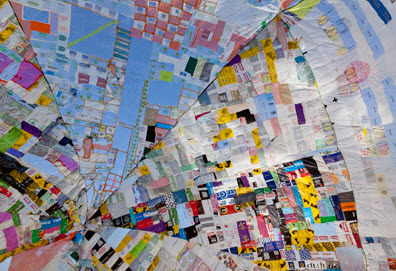Abstract
Performing shared atmospheres: Museo Aero Sola' explores the performative politics of shared atmospheres. More specifically, Sasha Engelmann investigates how the collectively fabricated sculpture Museo Aero Solar conjures particular atmospheres that connect bodies to each other and to their elemental circumstances. Engelmann traces historical performances of Museo Aero Solar (2007-) through the voices of key project leaders and collaborators. Thinking with these sites and encounters, she suggests that Museo Aero Solar manifests an interstitial politics: an affective politics formed of the capacity to generate a shared atmosphere and a space in common. An attention to interstitial politics rescues the situation of being and breathing 'in common' while recognizing what the limits to this elemental commonality might be.
I. WITHIN THE MEMBRANE
Museo Aero Solar, 2007– ongoing.
At ON AIR, carte blanche exhibition to Tomás Saraceno, Palais de Tokyo, Paris.
Curated by Rebecca Lamarche-Vadel.
Initiated by artist Tomás Saraceno in conversation with Alberto Pesavento in 2007, Museo Aero Solar unfolds in the space formed between human and non-human participants in the simple acts of cooperation and reusing plastic bags, to collectively produce an aerosolar sculpture. Fostered in more than 21 countries to date, Museo Aero Solar embodies a vision of pollution-free futures through the growth of self-assembling, geographically dispersed participatory communities; in this way, the practice can be seen as marking the beginning of the genealogy of Aerocene. Courtesy Museo Aero Solar and Aerocene Foundation. Photo Aurélie Cenno, 2018, licensed under CC BY-SA 4.0
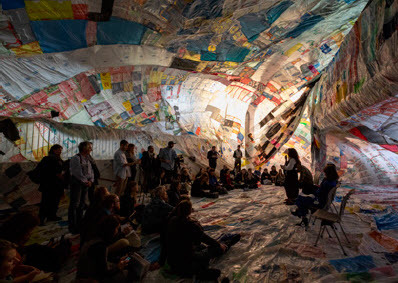
The Argentine anthropologist Débora Swistun is standing in the middle of an air-filled envelope inside the Palais de Tokyo, a prestigious venue of art and culture near the Champs-Élysées in Paris (see image above). Light percolates through the envelope’s surface, composed of numerous square and rectangular plastic sheets in many different colours. The membrane flutters slightly, its walls sustained by air circulated by fans through the interior space. It feels constructed, sheltering. A large group of attentive listeners sit cross-legged around Swistun. Speaking of her decades-long research and activism in Villa Inflamable (the ‘Flammable Town’) on the outskirts of Buenos Aires, a neighbourhood in the shadow of one of the largest petrochemical facilities in Argentina where she was born and raised, Swistun says:
After some frustrated collective action against pollution [in Flammable] I wanted to understand why it was so difficult to win: at least a resettlement, compensation, cleaning of soils, as I learned [were the outcomes] for several cases in the US of environmental justice. (2018: 1)
Bodies adjust and resettle into folds and piles of plastic. Hands play with smooth edges. Faces gaze up and around at the mosaic-like architecture. Speaking now of her collaborative work with the sociologist Javier Auyero, Swistun continues:
[In our ethnographic research] we focused on the public dimension of the toxic experiences of Flammable residents, the production of toxic uncertainty, all the actors involved in the labour of confusion about pollution, toxicity, damage on health and the environmental impact in a fenceline community that mainly developed a kind of organic relationship with the petroplants. (1)
The low background hum of ventilating equipment ceases as someone pulls the plug. The plastic surfaces stop their slight fluttering. They hang in suspension. The atmosphere in the envelope grows more still. Swistun continues:
We were starting to understand the multiple effects of the (polluted) environmental dimension in urban poverty, a dimension that had been marginal in academic studies about poverty in Latin America. We were bringing to the front the importance of [the] polluted environment in everyday life to understand how social domination works in places like Flammable. (1)
As Swistun speaks, those listening begin to notice the envelope around them getting smaller. The semi-transparent walls are relaxing, slowly giving way to the pressure of outside air. Without acknowledging this movement, Swistun presses on, describing the years of activism and community organization during which residents, including herself, tried to persuade the Supreme Court of Argentina to honour its promise to enforce a 2008 ruling to clean up the contaminated basin of the Matanza-Riachuelo River, along which Villa Inflamable is based, and to make reparations for decades of environmental harmFootnote1. The actions stalled or failed, she explains. Then, she says:
After ten years of the Supreme Court ruling I still have a question in my mind without a definite answer. And it is as follows: why don’t the lives [of people in Flammable] matter as [much as] yours who are here in this room? (1)
This question resonates for several moments. Light still shines through the envelope, but the atmosphere has changed entirely. Slowly a group conversation unfurls, punctuated by increasingly apprehensive stares at the caving surfaces. Yet no one tries to leave. As a large plastic fold finally comes gliding down from the vaulted ceiling to the floor, separating one half of the group from the other, the conversation stops abruptly. Several tall bodies hold the space open as others squeeze out through a floor-level hole in the now deflated envelope that had, moments earlier, seemed so unshakeable.
Swistun’s address inside the membrane of Museo Aero Solar, a collectively constructed sculpture exhibited in the Palais de Tokyo on the occasion of Tomás Saraceno’s carte blanche exhibition On Air, invites us to consider the politics and performances of shared atmospheres. These are atmospheres of being and breathing in common, in which the material-elemental properties of air inflect the transmission of affect. In other words, shared atmospheres are both meteorological and affective: the material properties of atmosphere influence, and are influenced by, the way the atmosphere is felt. At the same time, as Sara Ahmed argues, atmospheres are oriented, and they are ‘angled’ differently for different bodies (2014: n.p.). These angles and orientations extend into space and through time, so that atmospheric spacetimes may have a ‘tilt’ (Ahmed Citation2014: n.p.). Instead of smoothing the flow of affect among bodies or celebrating the qualities of the air/space in the membrane, Swistun’s words amplified the angles of the shared atmosphere.
To reflect on this event is also to think through an elemental politics of location. Introduced by black feminists in the Combahee River Collective and developed by Adrienne Rich, Audre Lorde, Gloria Anzaldúa and Rosi Braidotti among many others, the ‘politics of location’ is a feminist analytical tool that begins with ‘the geography closest in—the body’ (Rich Citation1986: 212). Rich writes of her scars, bones, skin and teeth as evidence of intersecting forms of privilege and struggle (1986). In an ‘elemental politics of location’ such analysis might also include the ways bodies are implicated in, and conditioned by, local and translocal movements of water, weather and soil (Neimanis and Hamilton Citation2018; Engelmann Citation2020). When Swistun invoked the landscape of Villa Inflamable inside the membrane of Museo Aero Solar from the site of a Parisian gallery, she was inviting her listeners to consider how bodies are implicated in local conditions, while weathering forces that extend far beyond them. Further, Swistun demonstrated how the interior atmosphere was not accidental or inconsequential; it was co-constructed by specific historical and material relationships to land, labour and resources. An elemental politics of location requires that we trace these atmospheric cartographies, however temporary or spontaneous they may seem (Neimanis Citation2013). It also requires that we think of the performance of shared atmospheres as the performance of connections and interstices: the invisible tethers that link bodies to each other and to their elemental circumstances.
To further engage these issues and questions, this article traces the performance of Museo Aero Solar, understood as both a shifting community of practice and a particular type of nomadic, aerial sculpture. More specifically, Museo Aero Solar is an aerosolar sculpture: a pneumatic envelope that floats with the energy of the sun and the movements of the atmosphere. It does not require the burning of fossil fuel or the use of helium or hydrogen gas to become airborne. As its name suggests, it is a flying museum and an archive of plastic matter, consumption patterns and urban ecologies. Over its lifetime, Museo Aero Solar crossed from global north to global south and back again, forming affiliations with different places, initiatives and struggles. By highlighting some of these ‘landings’, we can identify Museo Aero Solar’s performative politics, born of the collective work of fabricating, enveloping and floating with the sun and the air.
II. INTERSTITIAL POLITICS AND PERFORMANCE
Museo Aero Solar is, in a literal sense, an object of interstices. The term ‘interstice’, from the Latin intersistere or ‘to stand between’, has a physical meaning epitomized in the multiple edges and pieces of a Museo Aero Solar sculpture. Museo Aero Solar is animated by a design, a concept and a way of practising that is about connection and tension applied to a raw material: reused plastic shopping bags. The bags are cut into rectangular shapes and connected using adhesive tape, glue or a hot iron (see images on pages 32 and 33). After a large sheet has been created, the plastic is then folded over itself to produce an envelope. When warmed by the sun, this envelope transfers energy to the air inside, which becomes less dense than the air outside, generating lift. A Museo Aero Solar sculpture can quickly gain altitude, sometimes with enough force to raise a human off the surface of the earth. Thus, the process and materiality of Museo Aero Solar suggests that ‘knowing what a material is capable of when a tension is applied to it—recovering its original form, remaining folded, breaking—depends on interstices’ (Pignarre and Stengers Citation2011: 111).
However, the interstices are not only those of bag-to-bag seams but also those of hand-to-hand, body-to-membrane and body-to-body. Another important interstice is the one between Museo Aero Solar and the local atmosphere in which it is constructed and performed. Indeed, ‘interstice’ has an atmospheric register, in the sense that atmosphere has often been understood as that which circulates between bodies, and through the pores of bodies, devices and things (Anderson Citation2009: 77; Nieuwenhuis Citation2019). The interstitial qualities of Museo Aero Solar also enable it to be reproduced in many places. In this way, the project is shared without the need for enormous budgets, expert skills or specific venues. While scholars such as Kwon have critiqued participatory art that travels to ‘one place after another’, a process that can exacerbate power relations and ‘remythify’ the artist (Kwon 2002: 6), Museo Aero Solar is more malleable and pragmatic in its determination of community involvement. Museo Aero Solar’s process of fabrication from thousands of plastic pieces—the construction of interstices—means that the project’s relationship to site and audience is not predefined. These relationships emerge through the slow labour of connecting plastic edges into a balloon-like membrane.
Museo Aero Solar, 2007– ongoing.
At Milano, Italy, in 2007, with Maurizio Bortolotti, Alberto Pesavento, Tomás Saraceno and the support of Isola Art Center. Courtesy Museo Aero Solar and Aerocene Foundation.
Photo Studio Tomás Saraceno, licensed under CC BY-SA 4.0
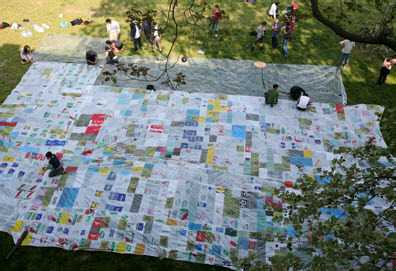
The first Museo Aero Solar sculpture workshop took place in 2007 in the United Arab Emirates, on the occasion of the 8th Sharjah International Biennale. However, it wasn’t until Tomás Saraceno was invited to a residency at the Isola Arts Centre in Milan that Museo Aero Solar achieved a more recognizable form. There, Saraceno worked with Alberto Pesavento as well as hundreds of local volunteers in the Art and Neighbourhood Center in Isola (Isola Arts Centre Citation2007: n.p.). Drawing parallels with other forms of collective making, Sacchetto describes an Isola workshop: ‘It was like a sewing class, and the aim was, as it continues to be, to spend some time with other people’ (2011: 8; see image page 33). After many trials, participants discovered that the best way to inflate the envelope was to channel warm air from urban vents leading from underground transportation systems. Rather poetically, one of the first large-scale Museo Aero Solar sculptures was inflated with the subterranean ‘breath’ of an urban neighbourhood. After months of work, the first launch took place in a public garden, which had particular significance as a part of the neighbourhood that had withstood pressure from redevelopment forces. Sacchetto elaborates: ‘Museo Aero Solar had its first flight in this very highly charged situation, even if on the day of the flight, there was a really friendly and spontaneous atmosphere’ (8).
The atmospheres of Museo Aero Solar in Isola acted as lures for the future; they profoundly moved bodies, elicited interest and resonated in the imaginations of those involved. Later in 2007, Museo Aero Solar was invited to the Encuentro Internacional in Medellín, Colombia. On this occasion, Saraceno and Pesavento travelled together as project ambassadors. They worked with local groups to prepare the sculpture for one month, at first simply staging the workshop outside and inviting anyone who was interested to join, in the manner of many urban participatory performance practices. Although my own knowledge of this ‘landing’ is limited, Sacchetto reflected that this instantiation of Museo Aero Solar engaged the socio-political ‘weather’ of Medellín, since the aim was ‘to develop not only an artistic discussion, but also a political and social discussion about the hard healing process of the city where public life had been deconstructed by years of violence’ (14). It was in Medellín that the performance of Museo Aero Solar came to involve playful inscription: children began to draw on the plastic canvas, initiating what would become a palimpsest that continued growing in future sculptures. Thus, the encounters in Isola and Medellín tested several values of the project: the involvement of local participants in every aspect of fabrication and construction, the feeling of a ‘collective property’ of actions and a focus on the quality of time spent together (Sacchetto Citation2011). Many of those involved with these events gradually cohered into the Museo Aero Solar community: a fluctuating group of volunteers who invested time, funds and energy into developing the project and bringing it to new places. Although Saraceno and Pesavento played important leading roles in these early days, other people, including Benedikte Bjerre, Maria Giulia Cantaluppi, Janis Elko, Simon Gillard, Till Hergenhahn, Theresa Kampmeier, Daniel Kohl, Dominik Mader, Alice Pintus, Jatun Risba, Tim Rottiers, Michela Sacchetto, Berth Theis and Fani Zguro, formed an important Museo Aero Solar leadership from 2008 to 2014Footnote2.
The subsequent ‘landings’ in Tirana, Kosovo and Ein Hawd, Israel in 2008 were not as ‘pivotal’ as those in Medellin and Isola (Sacchetto Citation2011). Nevertheless, these events reveal important dimensions of the performative politics of Museo Aero Solar. In Tirana, the date of the Museo Aero Solar launch coincided with Kosovo’s declaration of independence from Serbia. As a crowd marched and mingled on this day of national pride, Museo Aero Solar hovered like a spherical banner or flag above them. Hence, ‘by coincidence’, Museo Aero Solar ‘fit very well’ in the enthusiastic celebrations (Sacchetto Citation2011: 10). This was due, Sacchetto says, to ‘the versatility of Museo in its being a stratification of meanings and in adapting itself to specific context’ (10). As Hergenhahn states more succinctly, ‘it’s very easy to project something onto a balloon’ (2019: n.p.). Thus, Museo Aero Solar’s performative mutability was noted as a feature of its politics from its early days. That is, the project’s capacity to amplify a joyous atmosphere in public performances is ‘intensified, and given volume, through the shape of the envelope’ (McCormack Citation2018: 210).
In the following year additional workshops and launches took place at the Aeronauten Werkstatt in Frankfurt and Territoria 4 in Prato, Italy. In 2009, Hergenhahn told me, the Prato organizing team faced a crisis when many members lost motivation to launch the sculpture after days of bad weather. On the last possible day, the weather was so fantastic that the sculpture inflated and warmed up quickly, and a child was lifted one metre into the air. The atmosphere of this event has become somewhat legendary: the qualities of the meteorological weather and the combined energies and dispositions of the participants in Prato produced a rare alchemy of the elemental and affective that culminated in a feat of floating.
Museo Aero Solar, 2007– ongoing.
At Prato, Italy, in 2009 with Alberto Pesavento, Tomás Saraceno, Janis Elko, Till Hergenhahn, Giovanni Giaretta, Marco, Alessandro, Manuel Scano, Michela Sacchetto and Matteo Mascheroni.
Courtesy Museo Aero Solar and Aerocene Foundation.
Photography by Janis Elko. Licensed under CC BY-SA 4.0.
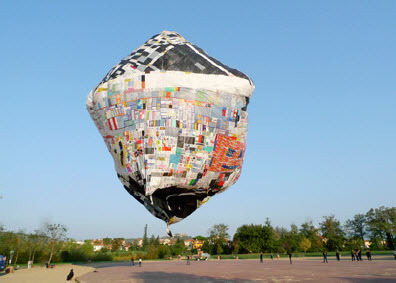
Members of the community had long discussed the relationships between the first Museo Aero Solar sculpture and the younger, lighter versions that were subsequently constructed. The organizing team agreed that the initial, increasingly heavy Museo Aero Solar sculpture should become more like a ‘cell’ that could be divided into multiple entities (Hergenhahn Citation2019). They felt that splitting up the single large sculpture would physically represent the nature of Museo Aero Solar as ‘an action, a multiform concept, an instrument to gain other imaginaries’ (Sacchetto Citation2011: 12). For members of the community, the existence of multiple sculptures is thus less important than the notion that Museo Aero Solar is ‘a sharable action that everyone [can] do, start, diffuse’ (12).
Furthermore, as is evident in the accounts of Sacchetto and others, affective atmospheres of celebration are common in Museo Aero Solar performances. In other words, there are atmospheric dimensions of Museo Aero Solar that are relatively consistent across time and space. Alongside the physical work of connecting interstices, and the performance of interstitial relations among bodies and atmospheres, the work engages in an interstitial, affective politics, formed by the capacity to generate a shared atmosphere and a space in common. It is interstitial not only because of its relation to a collectively fabricated envelope but also because it can be reproduced in many places simultaneously. This politics is interstitial, too, because it materializes in an atmosphere that propagates elementally and affectively among and between bodies. In this way an interstitial politics is performative: it depends on the rehearsal and reproduction of particular shared atmospheres.
Museo Aero Solar, 2007– ongoing.
At Frankfurt, Germany, in 2009, with Alberto Pesavento, Giovanni Giaretta, Marco, Alessandro, Manuel Scano, Michela Sacchetto, Simon Gillard, Mara Ferreri, Kim, Fabrizio, Gaia Fugazza, Cristian Raimondi, Matteo Mascheroni, Till Hergenhahn, Rolf, Janis Elko. Courtesy Museo Aero Solar and Aerocene Foundation.
Photo Studio Tomás Saraceno, licensed under CC BY-SA 4.0
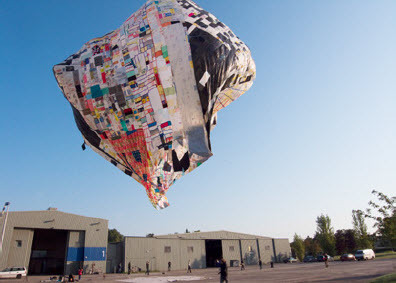
As I demonstrated in the opening vignette, the production and performance of shared atmospheres does not mean that atmospheres are felt in the same way, or to the same degree. The atmospheres of Museo Aero Solar are angled and tilted in particular ways that have largely unspoken consequences. Jatun Risba writes:
having personally experienced the strong sensorial aspect of a [successful] flight, its powerful ‘magic’, I am tempted to say that this magic will last, as in the case of any other spell, only until it won’t get trivialized or taken for granted. (2009: 2)
Risba goes on to suggest that a launch must be used ‘tactically’ and should be considered in the context of what it produces in a given situation, a given atmosphere. In other words, Risba invites the community to invest critical attention in the performance of Museo Aero Solar. Underlying Risba’s words is the notion that the infectious ‘magic’ or ‘spell’ of Museo Aero Solar does not mean its atmospheres are mutually felt, are uniformly shared or necessarily benign.
III. ELEMENTAL POLITICS OF LOCATION
During my time as an ethnographer at Studio Tomás Saraceno between early 2014 and late 2016, I also participated in this history through Museo Aero Solar workshops in Toulouse, Berlin, Vienna, Paris and Braunschweig (see Engelmann Citation2020). Based on practices learned from these experiences, I led several Museo Aero Solar workshops in London, one of which produced a smaller sculpture that was added to the larger membrane exhibited in the Palais de Tokyo in 2018. Many other groups have constructed sculptures, for example in Mississauga, Buenos Aires, Toulouse, San Francisco and Shanghai. According to Hergenhahn, there is a large Museo Aero Solar ‘cell’ at the Aeronauten Werkstatt in Frankfurt. Another one has been kept in Tomás Saraceno’s studio and was exhibited at the Palais de Tokyo, where this article began. As one of the oldest Museo Aero Solar sculptures in existence, it is composed of sections made in over twenty countries. The logos on the plastic bags vary in languages and meaning: a testament to the diversity of places and atmospheres in which the sculpture has been performed.
A more nuanced understanding of the performative and elemental politics of Museo Aero Solar can be gained by returning to the deflation of the sculpture in the Palais de Tokyo during Débora Swistun’s speech. Initially a seemingly secure structure, the walls of this atmospheric entity collapsed in the aftermath of Swistun’s injunction: ‘why don’t the lives [of people in Flammable] matter as [much as] yours who are here in this room?’ (Swistun Citation2018: 2). This question invokes an elemental politics of location. Swistun gestured to the historical and bodily exposures of those living in Villa Inflamable, and, simultaneously, to the socio-political frameworks that sustain forms of oppression in the global south. She gestured to the plastic, a material by-product of the petrochemical industries, as she told stories of life adjacent to a petrochemical facility. As she explained, the name ‘Flammable’ originates from the 28 June 1984 event of a fire on the Perito Moreno, an oil tanker harboured in a nearby canal. Today, Villa Inflamable is a place where ‘50 percent of the children tested … have blood levels that exceed the level at which people are declared to be lead poisoned’, with inhabitants exposed to chromium, benzene and toluene as a result of nearby petrochemical, waste-processing and incinerator facilities (Auyero and Swistun Citation2009: 53). In a series of fieldnotes collected on 8 January 2005 and published in Flammable: Environmental suffering in an Argentine shantytown, Swistun describes an incident of Villa Inflamable’s weather:
I’m still inside. I don’t know whether the smell is still out there. I can’t smell a thing here. Every time there’s this kind of odor we close everything; it is as if we are surrounded by decomposed garbage. After five minutes or so, my mom tells me that the smell is gone. She tries to convince herself by saying: ‘It might be the weather.’ ‘Yes,’ I reply, ‘it’s Flammable’s weather … the stinking smell of the cinturón ecológico [the name of the nearby landfill]’. (Auyero and Swistun Citation2009: 53)
For residents of Villa Inflamable, the waste and petrochemical industries are not only experienced as effects on the climate; they also create local weather. In their ethnographic writing, Auyero and Swistun marshal testimonies that speak to a multitude of such events. Yet, Auyero and Swistun argue, because of the contradictory, manipulative and incongruous actions of state, corporate and municipal officials, residents of Villa Inflamable exist in a state of ‘toxic uncertainty’, trying to maintain daily rhythms as they are repeatedly disrupted by elemental patterns and atmospheres unique to the neighbourhood (Auyero and Swistun Citation2009).
All of this, and much more, was held within the words Swistun spoke in Museo Aero Solar in October 2018. Whether Museo Aero Solar’s subsequent deflation was intentional or accidental, in reflecting on the event since I think it is significant that it occurred in this way and at that time. It is significant because it evoked a visceral reaction to Swistun’s words: the deflation of the sculpture can be understood as a puncture in the atmospheric fabric of the symposium and the wealthy Parisian venue as Swistun pointed out the historical privilege and inequity on which the conditions of the gathering were predicated. At the same time, the sculpture’s deflation allegorized the fact that no matter how different a group of bodies might be, they may share a common atmosphere. The caving membrane of Museo Aero Solar reflected the incommensurability of elemental experience while co-implicating an assembly of bodies in atmospheric conditions: indeed, physically and affectively pressing on bodies as they evacuated the membrane.
Museo Aero Solar, 2007– ongoing.
At Roskilde, Denmark, in 2011, with Benedikte Bjerre, Giulia Cantaluppi, Vivana Deluca, Simon Gillard, Rasmus Johannsen, Theresa Kampmeier, Matteo Mascheroni, Tim Rottiers, Lionel Wolberger. Courtesy Museo Aero Solar and Aerocene Foundation.
Photo Studio Tomás Saraceno, licensed under CC BY-SA 4.0, courtesy of Museo Aero Solar and Aerocene Foundation

IV. PERFORMING ATMOSPHERES
Museo Aero Solar’s performative and elemental politics is not free of tensions. Yet, as the sculpture’s various ‘landings’ demonstrate, the project can operate as a powerful affective and political device both within and between communities and locations. This insight has implications for the performance of Museo Aero Solar. It would mean, as Risba suggested in 2009, not assuming that the sculpture must be launched in order to become a tactical political entity. Rather, Museo Aero Solar might be performed in ways that diverge from its physical status as a balloon. Enabling greater flexibility in the performance of Museo Aero Solar would offer other modes of linking the project to political struggles that might not necessarily include moments of inflation and celebration. Different approaches to performing the sculpture and its atmospheres would resonate with a wider set of political positionalities. Thinking of Museo Aero Solar in these terms enables a different reading of its collapse inside the Palais de Tokyo. As the walls of the weakened membrane folded inwards, another spell was cast: a spell of quiet, concentrated solidarity, of organized escape and of visceral proximity to an elemental envelope that pressed down upon the life inside it.
To apprehend the performative politics of shared atmospheres is to trace their affective potency and elemental materiality alongside the many forms of power suspended within them. This does not mean resisting feelings of excitement and exuberance when they emerge, but it does mean turning a critical eye to what these affective textures produce and what they may elide. Although the figuration of the interstice is particularly fitting for the performance of Museo Aero Solar, it has wider potential, whether for specific social conditions, collective rituals or public praxis. Much has been written in performance studies, human geography and art history about the challenges to place, site and location under globalization and advanced capitalism. An equally extensive literature has addressed shifting definitions of community. An attention to the performative politics of shared atmospheres offers another lure for these debates, one that rescues the situation of being and breathing ‘in common’ while recognizing what the limits to this elemental commonality might be.
Notes
1 In July 2004, a group of residents of the Matanza/ Riachuelo basin led by activist Beatriz Mendoza filed a suit before the Supreme Court of Argentina, against the national government, the Province of Buenos Aires, the City of Buenos Aires and forty-four companies, seeking compensation for damages resulting from pollution of the basin, stoppage of contaminating activities and remedy for collective environmental damage. In July 2008, the court issued a decision in which it required the national government, the Province of Buenos Aires and the City of Buenos Aires to take measures to improve the residents’ quality of life, remedy the environmental damage and prevent future damage (ESCR-net Citation2019: n.p.).
2 This shortlist was provided to me by Till Hergenhahn. A complete list of Museo Aero Solar community members is available at: https://bit.ly/3EMurCW; here I want to note the many other people involved in Museo Aero Solar, with the caveat that this list is still partial: Tell Andersson, Saga Asgeirsdottir, Simo Barbagallo, Hoxha Besart, Benedikte Bjerre, Bob Sleighs, Juan Camilo, Maria Giulia Cantaluppi, Renaud Codron, Marc Colombaioni, Rolf Degel, Vivana Deluca, Pablito El-Drito, Janis Elko, Mara Ferreri, James Flaten, Gaia Fugazza, Giovanni Giaretta, Simon Gillard, Till Hergenhahn, Andria Hickey, Juan Camillo Jaramillo, Rasmus Johannsen, Theresa Kampmeier, Daniel Kohl, Oliver Kral, Dominik Mader, Eduardo Ernesto Marengo, Persichina Matteo, Matteo Mascheroni, Natalija Miodragovic, Mohamed Nageh, Mustapha Nageh, Dragusha Njomza, Marco Orlando, Osmani, Sabine Pahl, Eduardo Perez, Alberto Pesavento, Alice Pintus, Cristian Raimondi, Yasmil Raymond, Barrak Reiser, Christiana Rekada, Jacob Remin Sikker, Hoti Rinor, Jatun Risba, Hannah Rosales, Iuri Rottiers, Tim Rottiers, Matteo Rubbi, Michela Sacchetto, Hugo Santamaria, Tomás Saraceno, Lahu Saranda, Manuel Scano, Saverio Tozzi, Emek Ulusay, Alejandro Uribe, Mauro Vignando, Lionel Wolberger and Fani Zguro.
REFERENCES
- Ahmed, Sara (2014) ‘Atmospheric walls’, Feminist Killjoys, 15 September, https://bit.ly/3vJangC, accessed 20 September 2019.
- Anderson, Ben (2009) ‘Affective atmospheres’, Emotion, Space and Society 2(2): 77–81. doi: 10.1016/j.emospa.2009.08.005
- Auyero, Javier and Swistun, Débora (2009) Flammable: Environmental suffering in an Argentine shantytown, Oxford: Oxford University Press.
- Engelmann, Sasha (2020) Sensing Art in the Atmosphere: Elemental lures and aerosolar practices, London: Routledge.
- ESCR-net (2019) Mendoza Beatriz Silva et al vs. State of Argentina et al on damages (damages resulting from environmental pollution of Matanza/Riachuelo river). File M. 1569. XL. Available at: https://bit.ly/3Kg1bFx
- Hergenhahn, Till (2019) Interview with Sasha Engelmann, 30 October [via phone].
- Isola Arts Centre (2007) ‘SituazionIsola: A new urbanism’, https://bit.ly/3MvAePL, accessed 25 September 2019.
- Kwon Miwon (2002) One Place after Another: Site-specific art and locational identity, London: MIT Press.
- McCormack, Derek P. (2018) Atmospheric Things: On the allure of elemental envelopment, Durham, NC: Duke University Press.
- Neimanis, Astrida (2013) ‘Feminist Subjectivity, watered’, feminist review 103(1), 23–41. doi: 10.1057/fr.2012.25
- Neimanis, Astrida, and Hamilton, Jennifer Mae (2018) ‘open space weathering’, feminist review 118(1): 80–4. doi: 10.1057/s41305-018-0097-8
- Nieuwenhuis, Marijn (2019) ‘Porous skin: Breathing through the prism of the holey body’, Emotion, Space and Society 33: 1–8. doi: 10.1016/j.emospa.2019.100595
- Pignarre, Philippe and Stengers, Isabelle (2011) Capitalist sorcery: Breaking the spell, trans. A. Goffey, Basingstoke: Palgrave Macmillan.
- Rich, Adrienne (1986) ‘Notes toward a politics of location’, in Blood, Bread and Poetry: Selected prose, 1979–1985, London: Virago.
- Risba, Jatun (2009) ‘Considerations (for) Museo Aero Solar’ [personal correspondence shared with author 22 November 2019].
- Sacchetto, Michela (2011) ‘Museo Aero Solar speech’ [on occasion of the 2011 Roskilde Festival, Denmark], Studio Tomás Saraceno archives, Berlin.
- Swistun, Débora (2018) ‘Speech in Museo Aero Solar’, Aerocene symposium, Palais de Tokyo Museum, 26 October. [Programmed as part of the exhibition Tomás Saraceno: ON AIR curated by Rebecca Lamarche-Vadel].

